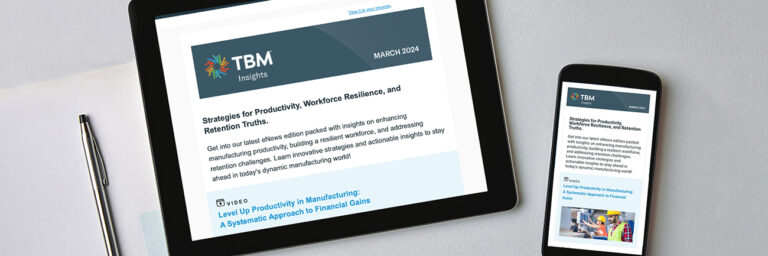Gaps in data, technology, and buy-in can keep your digitization project from getting off the ground.
As labor and supply chain challenges persist and inflationary pressures pile on top, manufacturers need the efficiencies and insights that connected operations can deliver. Digitization and Lean 4.0 strategies promise solutions. But technology adoption doesn’t always work, or it doesn’t work fast enough.
Our recent experience shows that there are three key reasons why digital projects fall short of goals:
- Poor master data
- Inefficient technical infrastructure
- Lack of buy-in from key stakeholders
When any one of these three elements is missing or lacking, it can topple the entire project or, at least, make it extremely difficult to gain any ground.
Remove roadblocks before you start and put your critical digitization projects on the fast track to success.
Here are three ways to get ahead of the issues, accelerate your project, and get to the benefits faster.
- Get your master data in shape. While there’s no such thing as perfect master data, most manufacturers are a long way from good enough. Ideally, to ensure the success of Lean 4.0 and other digital projects, you need data you can trust in six key areas:
- Customer data
- Item or product data
- Supplier data
- Standards (labor, machine times)
- Bill of Materials (BOMs)
- Work centers and routing definitions
Standardizing this information across the organization is key to efficient performance and performance tracking. The first step is to get away from spreadsheets—something that, according to a recent McKinsey article—is still being used by 73% of companies for supply chain planning1. Start using solutions that make real-time data available across the organization instead. And be consistent in how you refer to your data. Many times, simple inconsistencies in naming conventions can derail entire systems and prevent end-to-end connectivity across the business. For example, when part numbers don’t match up with product orders or drawings, it leads to manual interventions that cost time and money.
In a lot of cases, manufacturers don’t realize they have a data quality problem—or how significant it is—until they do a formal assessment. We work with one company where we heard rumors about “phantom” part numbers. The team knew they existed, but no one really understood the full implications for the business. Team members were manually creating parts numbers to designate kits of materials and facilitate picking the right parts. The “phantom” numbers were also being used for a made-to-order product required in a final assembly. The numbers existed in the bill of materials but were not being transacted. Therefore, all visibility into labor and machine time was lost for these make-to-order items, severing what we call the digital thread, and making it virtually impossible to connect the dots across the organization. Delivery and productivity suffered as a result. Ultimately, we facilitated a great deal of data cleanup work to remove the phantom numbers before we could move new digital efforts forward with confidence.
If you regularly operate off variances, this is an indicator that your data needs some attention. Another way to know you might have a data problem is to consider how often your customer service and order management team members are working around the system—and why. Your operations team will tell you it’s because the system doesn’t work. But your IT team will say it’s because people don’t know how or are not willing to use the system properly. Either way, it’s a problem. And you need to find out the root cause. While the work may ultimately be getting done, frequent manual interventions are inefficient and will leave you with data that does not reflect what’s actually happening in your business.
Dig in and go see for yourself what the issues really are. Sometimes it is the system’s fault. However, we often find that companies must revisit procedures and instill process discipline to prevent ad hoc workarounds. For example, rules for creating BOMs, updating routings, and properly recording changes to standards can help protect the integrity of your data and set up your digital projects for success.
- Put the right technical infrastructure in place. The more digital your operations become, the more they will rely on your IT backbone. In other words, you can’t introduce automation and advanced technologies like IIoT, digital standard work, workstation robotics, advanced analytics, and AI if you don’t have good connectivity on the shop floor. And your team can’t take advantage of the benefits these solutions deliver if they don’t have a way to easily access the information and insights.
We ran into such an issue with a manufacturer looking to roll out a new order management system. The company has an opportunity to remove 20% of the lead time in its order-to-cash cycle. But the manufacturer launched the new tool without first thinking through the entire process and the various connections needed to make it successful. Multiple issues that could and should have been solved prior to launch have delayed the implementation and discouraged the team.
To avoid such a situation, make sure you have a basic tech stack in place. At a minimum, your capabilities should include:
 |
Connectivity
From the top floor to the shop floor. Wireless or wired. Sensors. Shared databases and folders. All equipment is well placed and protected.
|
 |
Devices
Workstations, tablets, laptops, and/or digital performance boards. Strategically located and easy to access.
|
 |
Data visualization Software
At-a-glance insights. Dashboards. Alerts. Intuitive user interfaces.
|
 |
Time Tracking Capabilities
For labor and equipment times.
|
 |
People and Product Tracking Capabilities
For accurate inventory and workflow.
|
When building the tech stack, keep in mind how, where, when, and by whom different tools will be used. If shop floor technicians will be interacting with the systems, then desktop computers located away from work cells are likely not the best option. Tablets that can easily fit into the work environment may be the better bet. And while ERPs certainly have the capability to track inventory, a handheld barcode scanner is going to be a much better solution for accomplishing that on the shop floor.
It’s also important to be familiar with the full range of capabilities of each tool. A full-blown MES can track job times. However, a Visual Knowledge System (VKS) used for digital standard work can also perform this task. Similarly, an AI-based tool with visual recognition capabilities, like sys.AI, is gaining traction as a way to track people and products throughout the factory. The more knowledgeable you are about different systems, the more you will be able to optimize your investment in advanced technology.
- Get buy in from the get-go. It takes more than the right technology to enable digital adoption. It takes the right mindset, too. Manufacturers often make the mistake of overlooking the people side of the equation. However, digital adoption comes with a whole spectrum of changes for people at all levels. You can’t expect everyone to embrace them out of hand. Indeed, we’ve seen more than one implementation stalled by a lack of change readiness. Whether it comes from the c-suite, operations leaders, IT, the engineering team, or the shop floor, leaders and operators who are not onboard can throw up roadblocks faster than the highway patrol.
You need a project champion with the desire and authority to drive implementation forward and address issues as they pop up. While this person can potentially force through the changes, he or she will have a smoother and more successful journey if you create alignment from the beginning. Think through all the departments and processes that will be affected. Explain the changes and the business case or making them. When all leaders understand why the project is a priority and the immediate and long-term benefits, they will be more likely to become allies in your effort.
Set up your digitization project for success.
Digital and Lean 4.0 projects are the gateway to the connectivity and the visibility manufacturers need to solve their most pressing challenges now. But they easily can become more of a problem than a solution if they aren’t properly planned. Proactively address the roadblocks to digital manufacturing—poor data, insufficient infrastructure, and lack of buy in—before you get started. And lay the groundwork that will help your business reach its objectives faster.
https://www.mckinsey.com/business-functions/operations/our-insights/to-improve-your-supply-chain-modernize-your-supply-chain-it







